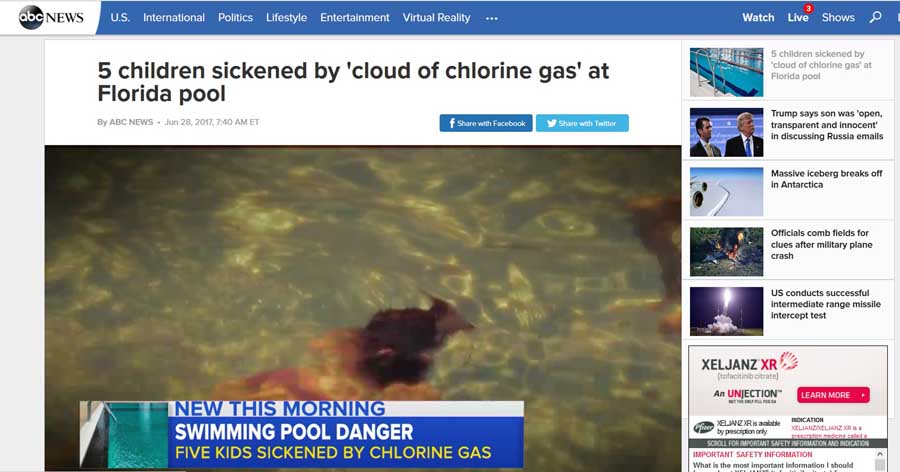
Chlorine Causes Illness and Burns for Kids in Pool
ChlorKing constantly cites safety as a reason to switch from bulk chlorine to salt-based onsite batch chlorine generators. Here are two incidents from this summer that support the switch to salt.
One incident was a freak accident, but in our opinion, it doesn’t matter. A chlorine gas cloud caused by a power interruption and surge still sent five young children to the hospital in Tampa, FL. Power-supply issues can happen anywhere, but with our NEX-GEN on-site batch chlorine generator, you won’t get a chlorine gas buildup in the water line.
The incident occurred in the Florida pool during a swimming lesson when a breaker for a pump tripped. That shut down the pump and caused the buildup of chlorine gas, which was released when the pump restarted. According to news reports, approximately 2.5 gallons of chlorine caused the reaction.
The Centers for Disease Control and Prevention reports that pool chemicals are responsible for some 5,000 emergency-room visits each year. CDC says chlorine gas poisoning causes a variety of symptoms that include nausea, vomiting, blurred vision, and in extreme cases fluid in the lungs (pulmonary edema) that may be delayed for a few hours.
The chlorine discharge in Tampa wasn’t the only incident this summer.
A water park in South Bend, IN was forced to close after 11 children suffered chemical burns following an equipment malfunction that sent too much chlorine into the children’s slide area.
Basic pool chemistry revolves around having the right amount of chlorine in the pool and making sure its pH is properly balanced. Typically, the chlorine should be 3 to 6 parts per million (PPM) to ensure it kills bacteria and prevents algae growth. Combining chlorine and water creates hydrochloric acid, and that’s what sanitizes the pool.
During use, however, the balance between acidity and alkalinity can be upset. Constant monitoring of pH levels is required to know when to add other chemicals, such as muriatic acid. When chlorine in its concentrated form comes in contact with muriatic acid, this creates the possibility of forming a dangerous gas or causing a fire. While all pool personnel should be trained in properly handling both chemicals, some people forget their training or are prone to having an accident if they are rushing to do too many things in too short a time.
On-site safety issues associated with chlorine and muriatic acid can be eliminated by using salt to produce bleach to sanitize pools. In practical terms, pool operators know that liquid chlorine is commonly used in pool as a sanitizer, typically as sodium hypochlorite (NaOCl), which the chemical equivalent of bleach. On-site batch chlorine generators produce that same end product using salt as their raw material instead of chlorine, and they add a few benefits.
Salt-generated chlorine should be pH-neutral, with generators having the ability to control the pH of the chlorine at a range of 7-8. This eliminates the need to add muriatic acid, and along with the elimination of chlorine, it eliminates the safety concerns.
The ABC News reporter covering the Florida incident told viewers the key question parents should ask is: How often is the pool water tested?
The better question everyone should ask is: Why are you risking swimmer safety by still using chlorine?

Leave a Reply